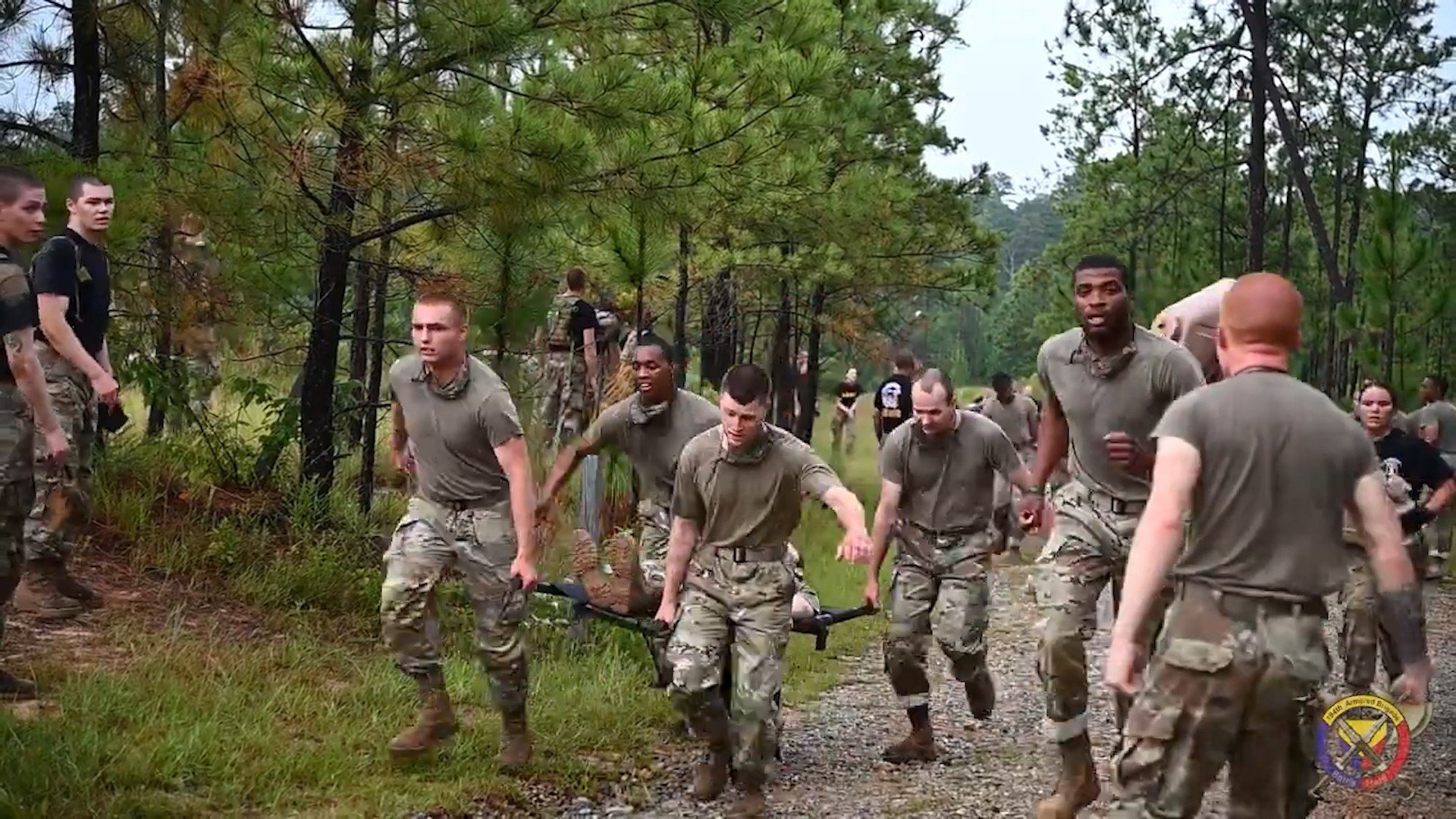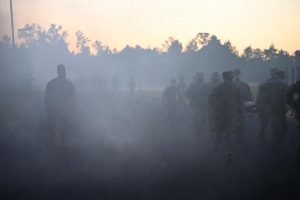Army Replaces ‘Shark Attack’ With Team Event For Tank Crewmen, Cavalry Scout Trainees

An image from a recent Army video shows recruits starting training here to become cavalry scouts taking part in an event designed to instill teamwork and attention to detail on their first day of training. Called the “Thunder Run,” the event replaces the traditional “shark attack” in which drill sergeants swarmed newly arrived trainees and shouted orders and belittling comments to gain immediate compliance. The 194th Armored Brigade, which trains the Army’s armor crewmen and cavalry scouts, adopted the Thunder Run several months ago as a replacement for the shark attack, which had come to be viewed as an outmoded vestige of the Vietnam-era military draft. Army photo
FORT BENNING, Ga. – Those who train the Army’s tank crews and cavalry scouts have dropped the traditional “shark attack” in which bellowing drill sergeants would swarm new recruits, and replaced it with an exercise that builds teamwork and attention to detail under pressure.
Called the “Thunder Run,” it requires Armor recruits on their first day of training to work under time pressure to find the fastest, most efficient way to move an assortment of equipment by carrying it at a run along a quarter-mile track, handing off to teammates at four points along the way, then setting the items down at the end in the same way they were arranged at the first location. Errors are penalized with push-ups or other exercises.
They adopted the Thunder Run several months ago for recruits attending Armor One-Station Unit Training here, a 22-week stretch that trains two types of Armor Soldier: the armor crewman, known by the job code 19 Kilo, and the cavalry scout, coded 19 Delta.
“Nothing’s really changed other than we’re not screaming in their faces,” said Command Sgt. Maj. Thomas D. Yaudas, senior enlisted leader of the 194th Armored Brigade, which trains the tankers and scouts.
The brigade is an element of the U.S. Army Armor School, part of Fort Benning’s U.S. Army Maneuver Center of Excellence.
The act of replacing the shark attack with a team-building event grew out of deliberations that began last year at the U.S. Army Infantry School here. The School’s senior enlisted leader, Command Sgt. Maj. Robert K. Fortenberry and its commandant, Brig. Gen. David M. Hodne, believed the shark attack was outmoded and should be replaced. With Hodne’s backing, Fortenberry and five other senior command sergeants major developed an Infantry-oriented team-building event that they came to call “The First 100 Yards.”
The U.S. Army Training and Doctrine Command (TRADOC) later called for training centers Army-wide to discontinue the shark attack and adopt their own versions of The First 100 Yards, tailored to the history and other specifics of the military career fields they train recruits for.
“It’s all about attention to detail under pressure, and remembering things that stick out. To adhere to exacting standards. Cause in combat, there are no second chances.” – Command Sgt. Maj. Thomas D. Yaudas, senior enlisted leader of the 194th Armored Brigade
That led the Armor School to develop the “Thunder Run.”
Retiring the shark attack in no way means the Armor branch is going soft on training recruits, Yaudas said.
The brigade’s drill sergeants still take firm charge of trainees on arrival, but they avoid the shark attack’s in-your-face pile-on that was meant to jolt recruits into instant compliance.
“They’re still being held accountable, no one’s holding their hand, it’s not day camp, it’s not a nursery center,” he said. “They’re still being trained for combat. They still understand that drill sergeants are in charge. Drill sergeants aren’t something ‘nice’ to them just because we’ve taken away the screaming-in-the-face aspect of it.

“There’s still plenty of stress and mentorship and development that goes into each one of these trainees,” he said. “The standards of training are even more rigorous in some aspects than what we went through years and years ago.”
The shark attack, familiar to veterans of the Vietnam-era when many draftees filled the ranks, has since come to be seen as no longer appropriate.
“It was really drill sergeants being somewhat aggressive, getting into someone’s personal space,” said Yaudas. “You have two or three, sometimes four drill sergeants on one trainee yelling different things to confuse him.
“There was no real teamwork aspect to it,” he said. “It was all just, move from point A to point B as fast as possible, carry all your stuff, ‘Hurry up! Hurry up!’ Screaming and hollerin’ the whole time. If a guy fell down, people either stepped on him or stepped over him. It was really just a bad event overall. It didn’t really reinforce anything other than: drill sergeants are in charge. Which we already know: drill sergeants are in charge.
The shark attack, said Yaudas, was a draft-era “model that never evolved to what the current needs of the force are. The training methodologies have changed because society has changed. “They’re all a volunteer force, no one’s here against their will,” he said. “So based on emerging societal trends, we’ve gone away from the shark attack into the Thunder Run.”
The Thunder Run takes its name from the 3rd Infantry Division’s armored drives into Baghdad during the 2003 invasion of Iraq, which became known as “Thunder Runs” evoking the dash and blunt force of armored warfare.
“We picked Thunder Run in honor of 3rd I-D’s attack into Baghdad,” said Yaudas. “We tie it back to our Armor roots.”
The Thunder Run is intended to give recruits their first taste of the need for teamwork, to form the habit of focusing on details, and the need to be physically fit, said Yaudas.
In all, he said, the group has about three minutes to improvise a plan, then move out running.
“So it’s not a lot of time,” he said.
“The squad leader or the platoon guide has less than a minute to memorize the configuration of the equipment set, go back and game-plan it to the squad leaders and the rest of the people in the group, how they’re gonna carry their stuff from point A to point B, who’s carrying what, and then how they’re gonna set back up at the end,” he said.
“Once you give ’em the go, they start carrying stuff around under pressure from the drill sergeants – motivation and purpose – ‘Follow me’ kind of thing,” he said.
“And they run around the track, station to station, switching up who’s carrying what at each little marker,” he said. “They come back to their beginning start-point, have to re-set their equipment up in the same way that they were issued it. And if they don’t do that then there’s penalties for not meeting the standard, which is pushups or something like that.
“They hardly ever get it right, there’s something off,” said Yaudas. “We really emphasize the team over the individual. No one cares about the one guy doing well. It’s like ‘Well, the other people on the team, did they also accomplish the mission?’
“The end state is that everybody works as a team to accomplish the mission, and no individual Soldier is successful on their own,” he said. “They have to work together throughout the 22 weeks. This is the first thing they have to do to come together and start forming those bonds of comradeship.”
The two trainee categories, armor crewmen and cavalry scouts, have their Thunder Run in separate locations. To create at least some of the smoke and noise of combat, smoke grenades are used along with pneumatic devices that simulate explosions and gunfire.
And motivational music blares from speakers.
For the cavalry scouts it’s bugle calls and other cavalry-themed music. “So they kind of tie in the history of the cavalry,” said Yaudas.
For the tank crewmen, it’s “more rock music” including AC/DC’s “Thunderstruck” to convey “the shock-and-awe effect of heavy tanks,” he said.
In each case, groups of about 30 trainees have to move the equipment from start to finish by going one lap around the track, said Yaudas.

“And there’s four checkpoints along the track where they have to set the stuff down, transfer the load between the Soldiers and then start again. That way the same Soldier’s not carrying the whole load the whole time.”
For those training to become cavalry scouts, the gear is “like what a scout squad would have in a combat environment,” he said.
That includes the AT-4 anti-tank weapon, cans of ammunition, a small rucksack weighted with one or more metal objects – a kettlebell, weighted plate, or ammunition magazines – to give it about the weight of a field radio, as well as cartons of field rations and a mock casualty on a litter. The casualty is a training dummy.
For the armor crewmen, the load includes many tank-related items: dummy 120 mm tank rounds, a tank tow cable, track jacks, which are jacks that weigh about 35 pounds and are used for repair of tank tracks, as well as ammunition cans and other gear.
The aim in giving them scant time to figure up a plan is to foster quick thinking and attention to detail under pressure, crucial for combat, Yaudas said.
“Cause in combat arms,” he said, “especially scouts and tankers, attention to detail can mean the difference between life and death.
“For scouts, identifying a friendly vehicle or enemy vehicle, there’s a lot of nuance to doing that,” as there is in accurately reporting their position on the battlefield or keeping correct track of where their fellow-scouts are at a given moment.
“Same thing for tankers,” said Yaudas. “When they scan the battlefield they have to be able to properly identify any combatants on the battlefield and engage them” and otherwise perform amid fast-breaking conditions.
With the event over, the first sergeant congratulates them on having completing the first training task of their Army service, and tells them its rigors are typical of what they can expect in the coming 22 weeks.
“That teamwork is the key,” he said. “It’s the foundation of all that we do in the Armor branch and the Army, and this is just one small case of how teamwork can be effective.
“It’s all about attention to detail under pressure, and remembering things that stick out,” said Yaudas. “To adhere to exacting standards. Cause in combat, there are no second chances.”

Coffee or Die is Black Rifle Coffee Company’s online lifestyle magazine. Launched in June 2018, the magazine covers a variety of topics that generally focus on the people, places, or things that are interesting, entertaining, or informative to America’s coffee drinkers — often going to dangerous or austere locations to report those stories.
BRCC and Bad Moon Print Press team up for an exclusive, limited-edition T-shirt design!
BRCC partners with Team Room Design for an exclusive T-shirt release!
Thirty Seconds Out has partnered with BRCC for an exclusive shirt design invoking the God of Winter.
Lucas O'Hara of Grizzly Forge has teamed up with BRCC for a badass, exclusive Shirt Club T-shirt design featuring his most popular knife and tiomahawk.
Coffee or Die sits down with one of the graphic designers behind Black Rifle Coffee's signature look and vibe.
Biden will award the Medal of Honor to a Vietnam War Army helicopter pilot who risked his life to save a reconnaissance team from almost certain death.
Ever wonder how much Jack Mandaville would f*ck sh*t up if he went back in time? The American Revolution didn't even see him coming.
A nearly 200-year-old West Point time capsule that at first appeared to yield little more than dust contains hidden treasure, the US Military Academy said.












